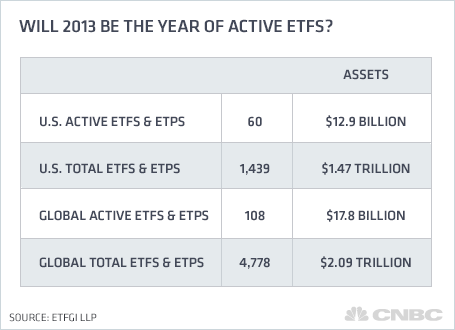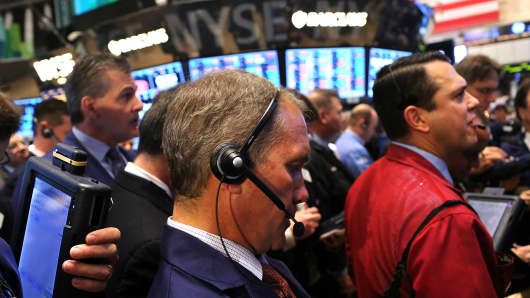Active ETFs are still a relatively recent innovation despite that the first index exchange-traded fund was launched in 1990 in Canada and the first index ETF was launched in the U.S. in 1993.
For investors, it's important to separate the excitement about active ETFs as a new investment product class from the reality.
The first active ETF products launched in 2008, and at the end of the first quarter of 2013, there were 108 active ETFs and exchange-traded products listed globally with $17.8 billion in assets from 18 providers, listed on nine exchanges.
A Relative Blip on the ETF Landscape
To put that growth in perspective, record net inflows of $73.4 billion in the first quarter helped to push assets invested globally in all ETFs and ETPs to a new all-time high of $2.09 trillion, according to figures from ETFGI's global ETF and ETP industry insights report. At the end of the first quarter, there were 4,778 ETFs and ETPs from 209 providers listed on 56 exchanges. Active ETFs and ETPs accounted for less than 1 percent of all assets invested in ETFs and ETPs.
The situation in the U.S. is similar to the global trend. The ETF and ETP industry in the U.S., which has 1,439 ETFs and ETPs from 53 providers on three exchanges, reached a record level of $1.47 trillion in assets at the end of the first quarter. There were 60 active ETFs and ETPs with $12.9 billion in assets, representing less than 1 percent of the total assets in ETFs and ETPs in the U.S.
(Read More: How Much Are Hidden Fund Fees Costing You?)
The questions surrounding the growth in active ETFs are interesting. Is it a defensive move by mutual funds to thwart the perceived threat of ETFs, which have been called a disruptive innovation, by trying to imitate ETFs? Or is the ETF industry trying to absorb traditional mutual funds?
To be sure, many traditional active asset managers have expressed an interest and have made filings with the Securities and Exchange Commission to launch active ETFs. It is likely that we will see new asset managers enter the ETF industry offering new types of strategies as active ETFs in 2013.
What Defines an ETF
For investors, answers to these questions about competitive industry positioning are less important than understanding exactly what distinguishes active ETFs from the much larger universe of index tracking ETFs, which are defined by:
•Transparency: typically the full list of holdings is published daily.
•Flexibility: trade and settle like stocks, with intraday pricing and trading, place stop and limit orders, increments of one share and go long or short like a stock.
•Cost effectiveness: the asset-weighted average total expense ratio for ETFs globally is 0.31 percent.
•Diversification: exposure to an entire benchmark.
•Indicative NAV: real-time value of the underlying portfolio is available.
•Liquidity: two sources—secondary, volume on exchange and primary, in-kind creation/redemption process trading the underlying holdings by authorized participants.
Like many imitations of successful products, the end result may not have all the benefits and features of the original, so the very principles that underpin the first and traditional ETF may be lacking in this new active ETF model.
What May Define an Active ETF
In the U.S., the SEC requires ETFs to provide transparency of their holdings and defines active ETFs as funds that do not track an index. Successful active equity managers are less willing to provide transparency on their "secret sauce," fearing "front running" of their trading strategies by other market participants.
Because mutual funds hold large positions in securities, it is difficult for them to move into and out of positions quickly. Some less well known active equity managers have been willing to run active ETFs with full transparency. These products have had limited success in raising assets and as such some have since closed.
Fund managers have also asked the SEC for the permission to launch active ETFs that invest in derivatives, and that regulatory issue has yet to be resolved.
In addition to gaining permission to launch transparent active ETFs and transparent active ETFs that will make use of derivatives, managers in the U.S. are trying to gain permission from the SEC to allow them to manage nontransparent active ETFs.
The proposals include proxy portfolios designed to mimic the performance of the real holdings while disguising an ETF's actual holdings, including structures that would not provide a real-time NAV. (See the proposed structure from Eaton Vance affiliate Navigate Fund Solutions for what it calls an ETMF: exchange-traded managed fund.)
(Read More: The Dilemma of the Do-Nothing Fund Investor)
With all of the issues surrounding the active equity ETFs, well-known fixed income managers are more likely to offer transparent active ETFs, as the benchmarks are much larger and bond investment strategies are harder to copy.
Two relatively new and successful active ETFs listed in the U.S. by Pimco are the Pimco Total Return ETF and the Pimco Enhanced Short Maturity ETF, with assets under management of $4.6 billion and $2.8 billion, respectively, at the end of the first quarter. These two ETFs account for 41% of all active ETF/ETP assets in the U.S.
The Bottom Line
Discussion about the characteristics of the active ETFs and how they differ from index ETFs should not obscure the most important issue of all in the investment industry: performance.
Active funds refer to a portfolio management strategy where the manager makes specific investments with the goal of outperforming a specific benchmark and hence delivering alpha. Active ETFs are not ETFs that are designed to track nonmarket cap or "smart beta" indices as some commentators have suggested.
We have years of historic data illustrating how difficult it is to find traditional active funds which consistently deliver alpha. There is no guarantee that the performance of active ETFs will deliver consistent alpha, and the performance and costs of active funds have been factors driving investors to embrace ETFs and ETPs.
The new S&P Indices Versus Active (SPIVA®) Scorecard, which has served as the de facto scorekeeper of the active versus passive debate, found that most active managers in the U.S. in all categories, except large-cap growth and real estate funds, underperformed their respective benchmarks in 2012.
Performance lagged behind the benchmark indices for 63.25% of large-cap funds, 80.45% of mid-cap funds and 66.5% of small-cap funds. The performance figures are equally unfavorable for active funds when viewed over three- and five- year horizons.
Since the launch of the first ETF, we have seen many challenges to starting a successful index ETF.
The challenges to overcome in launching a successful active ETF are much greater, and one of the main challenges is an age-old one for managers: consistently delivering alpha. It's a challenge most active fund managers find hard to do consistently in mutual funds. If active ETF managers can successfully tackle all of the structural and regulatory issues, when all is said and done, they still have to beat the benchmark.
Deborah Fuhr is a partner and founder of ETFGI, an independent research and consulting firm for the global exchange-traded fund industry.




